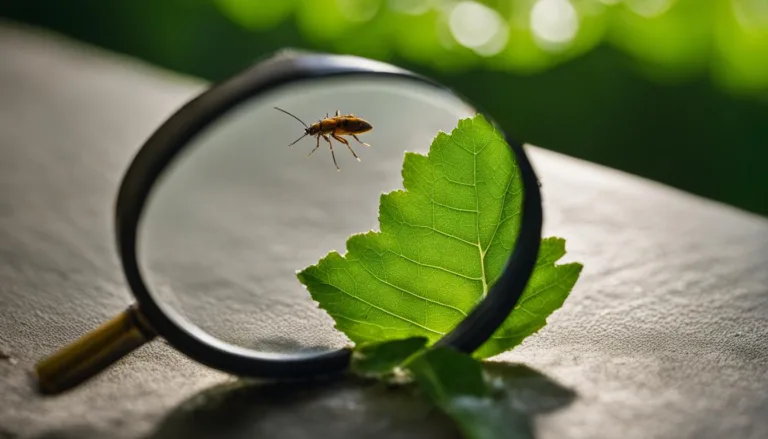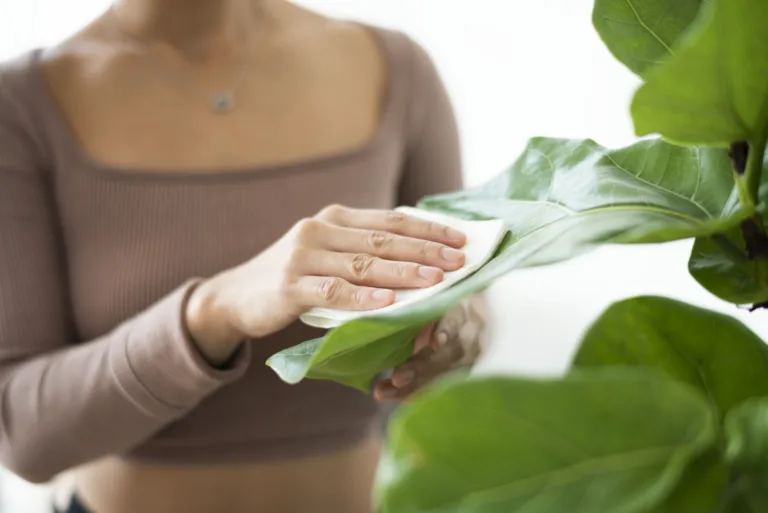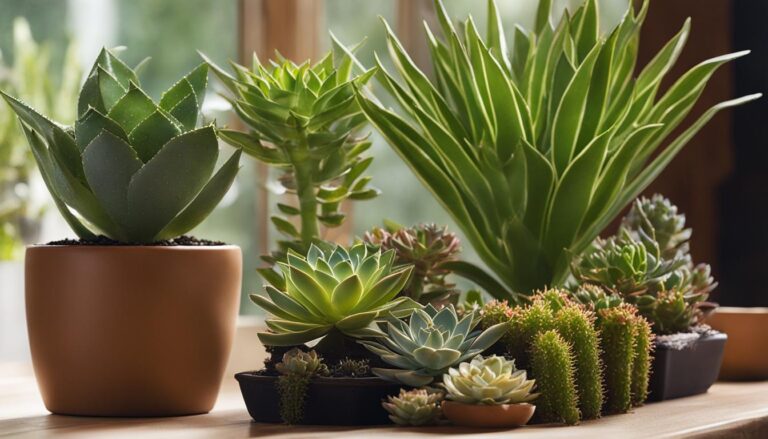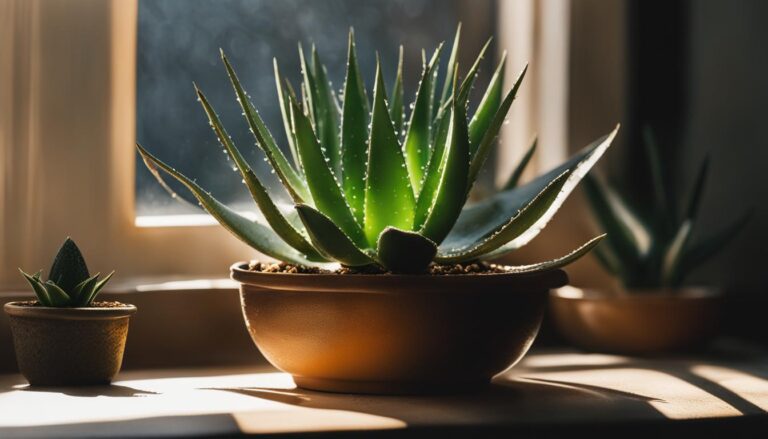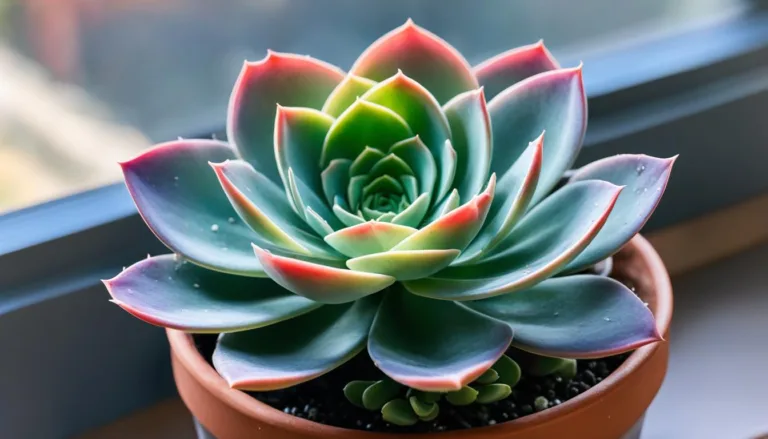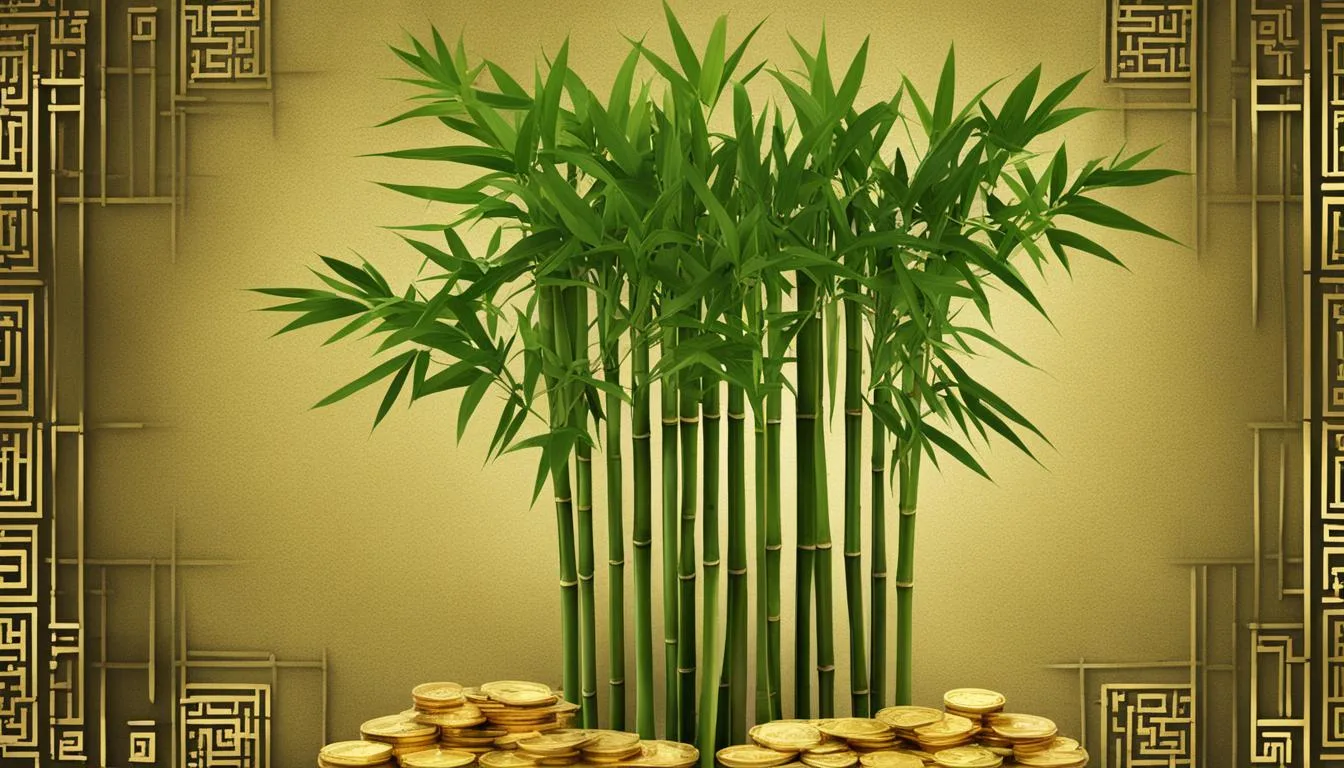
Hi there! If you’re looking to bring some luck and prosperity into your home, lucky bamboo is the perfect plant for you. Not only is it easy to care for, but it also adds a touch of natural beauty to any space.
Let’s dive into the world of lucky bamboo and discover how it can enhance your home’s ambiance and magnetize wealth.
Key Takeaways:
- Take care of lucky bamboo by providing indirect light and maintaining a temperature range of 65-95°F.
- The number of stalks in a lucky bamboo plant holds significance, with each number representing different meanings in Feng Shui.
- Lucky bamboo is considered a symbol of good fortune, prosperity, and resilience in Chinese culture.
- Grow lucky bamboo in either water or soil, ensuring proper care and regular maintenance.
- Lucky bamboo offers benefits such as air purification, stress reduction, and positive energy attraction.
The Symbolism and Meanings of Lucky Bamboo
Lucky bamboo holds deep symbolism and meanings in Chinese culture. It is considered more than just a plant, representing luck, prosperity, and resilience. The number of stalks in a lucky bamboo plant carries significant symbolism.
For example, three stalks symbolize continued growth and family, while five stalks represent wealth, longevity, and luck. However, four stalks are believed to bring bad luck and should be avoided.
Lucky bamboo is closely associated with Feng Shui, the ancient Chinese practice of harmonizing energy in the environment. Placing lucky bamboo in your home or office is believed to attract positive energy and bring harmony to the surroundings.
It is also believed to represent the five elements of nature: earth, wood, water, fire, and metal, making it a powerful tool for attracting wealth and success.
The symbolism of lucky bamboo extends beyond its visual appeal. It is believed to have air-purifying qualities, making it a popular choice for improving indoor air quality.
The plant is also thought to promote positive energy, reduce stress, and create a sense of calmness in its surroundings. As a result, lucky bamboo is often given as a gift to bring good luck, prosperity, and positive energy to the recipient’s life.
Lucky Bamboo Symbolism and Meanings
| Number of Stalks | Symbolism |
|---|---|
| 1 | Unity and simplicity |
| 2 | Love and partnership |
| 3 | Continued growth and family |
| 5 | Wealth, longevity, and luck |
By understanding the symbolism and meanings of lucky bamboo, you can enhance the positive energy in your space and invite good fortune into your life. Whether you believe in its mystical properties or simply appreciate its beauty, lucky bamboo is a wonderful addition to any home or office.
Lucky Bamboo Care Tips
When it comes to caring for lucky bamboo, following a few simple tips can help ensure its health and longevity. Whether you choose to grow it in soil or water, providing the right conditions is key to keeping your lucky bamboo thriving.
Soil Care:
If you prefer to grow lucky bamboo in soil, it is important to use well-draining soil that is rich in organic matter. To avoid overwatering, make sure the soil is slightly damp but not overly wet.
Remember to remove any yellow leaves to maintain the plant’s health, as they can indicate overwatering or other issues. Regularly check the moisture levels and adjust your watering frequency accordingly.
Water Care:
For those who choose to grow lucky bamboo in water, changing the water every week is crucial to prevent the growth of algae and bacteria. It is also important to use clean, distilled, or filtered water to avoid harmful chemical buildup.
Keep the water level high enough to cover the roots at all times. If you notice any discoloration or sliminess in the water, it may be a sign of poor water quality, and you should replace it immediately.
Light and Temperature:
Lucky bamboo prefers indirect light, so placing it near a window with filtered sunlight is ideal. Avoid exposing the plant to direct sunlight, as it can cause the leaves to burn. Keeping the temperature between 65-95°F (18-35°C) is recommended, as extreme temperatures can harm the plant. Avoid placing lucky bamboo near drafty areas or in locations with fluctuating temperatures.
Pest Control:
While lucky bamboo is generally resistant to pests, it can sometimes be affected by mealybugs or mites. If you notice any signs of infestation, such as white cotton-like webs or tiny crawling insects, you can manually remove them or treat the plant with a solution of rubbing alcohol and water. Be sure to thoroughly rinse the plant after treatment to prevent any damage.
By following these care tips, you can ensure that your lucky bamboo remains healthy and continues to bring luck and prosperity into your home or office.
The Benefits of Lucky Bamboo
Lucky bamboo not only adds beauty to your home or office, but it also offers several benefits that can enhance your well-being and create a positive environment. Here are some of the key benefits of having lucky bamboo:
1. Air Purification
Lucky bamboo is known for its air-purifying qualities. It has the ability to absorb harmful pollutants from the air, such as formaldehyde, benzene, and carbon monoxide. By having lucky bamboo in your space, you can improve indoor air quality and create a healthier environment.
2. Positive Energy and Stress Reduction
In Feng Shui, lucky bamboo is believed to attract positive energy and bring harmony to its surroundings. Having this plant in your home or office can help reduce stress, promote relaxation, and create a sense of calmness. The presence of lucky bamboo is said to promote a peaceful and harmonious atmosphere.
3. Prosperity and Good Luck
As its name suggests, lucky bamboo is associated with good fortune and prosperity. According to Chinese culture, it symbolizes wealth and resilience. By having lucky bamboo in your space, you can invite good luck and abundance into your life. It is often used as a gift for special occasions or as a personal talisman for attracting prosperity.
These are just a few of the many benefits that lucky bamboo can offer. Whether you are looking to improve air quality, create a serene environment, or attract good fortune, lucky bamboo is a versatile and meaningful plant that can enhance your life in various ways.
| Benefits of Lucky Bamboo |
|---|
| Air Purification |
| Positive Energy and Stress Reduction |
| Prosperity and Good Luck |
Growing Lucky Bamboo in Water
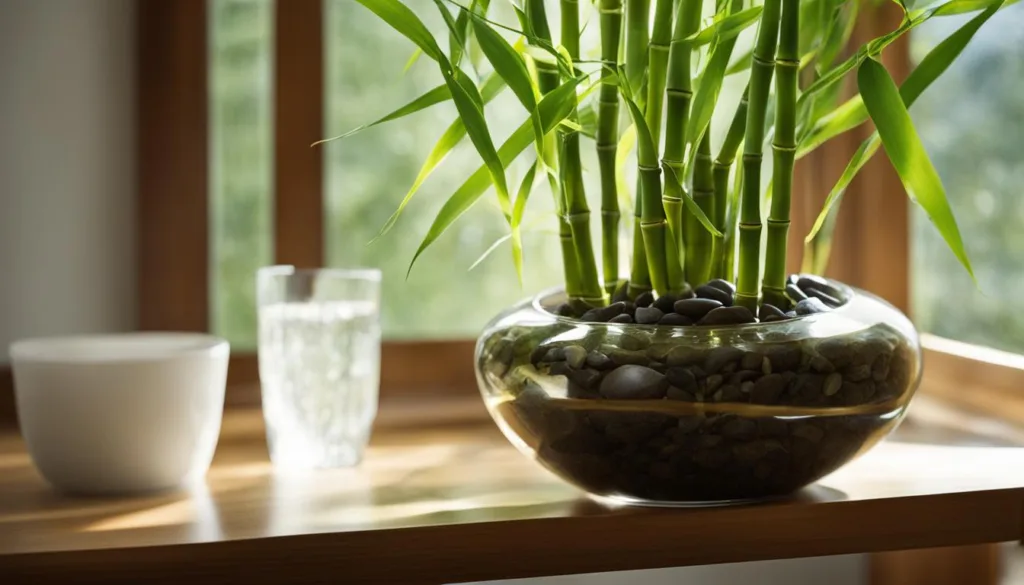
If you’re looking for a simple and aesthetically pleasing way to grow lucky bamboo, growing it in water is a popular choice. This method not only adds a touch of elegance to your home or office but also requires minimal maintenance.
To begin, you’ll need a clean container with enough room for the roots to spread. Fill the container with distilled or filtered water to ensure the plant’s health. It’s important to keep the water level high enough to cover the roots at all times.
Changing the water every week is crucial to prevent the accumulation of bacteria and algae, which can harm your lucky bamboo. Simply pour out the old water and refill the container with fresh, clean water. This routine maintenance will keep your plant healthy and vibrant.
If you want to further enhance the growth and overall health of your lucky bamboo, consider adding a few drops of liquid fertilizer to the water every few months. This will provide the necessary nutrients for the plant to thrive. Remember to follow the instructions on the fertilizer bottle to ensure proper dosage.
Care Guide for Growing Lucky Bamboo in Water
| Care Tips | Instructions |
|---|---|
| Container | Choose a clean container with enough room for the roots to spread. |
| Water | Use distilled or filtered water to keep the plant healthy. |
| Water Level | Keep the water level high enough to cover the roots at all times. |
| Water Change | Change the water every week to prevent the buildup of bacteria and algae. |
| Fertilizer | Add a few drops of liquid fertilizer every few months for optimal growth. |
Growing lucky bamboo in water allows you to appreciate the beauty of the plant while enjoying its symbolic meaning. It’s a great choice for those who prefer a hassle-free gardening experience. With proper care and attention, your lucky bamboo will bring a touch of nature and positive energy to your space.
Growing Lucky Bamboo in Soil
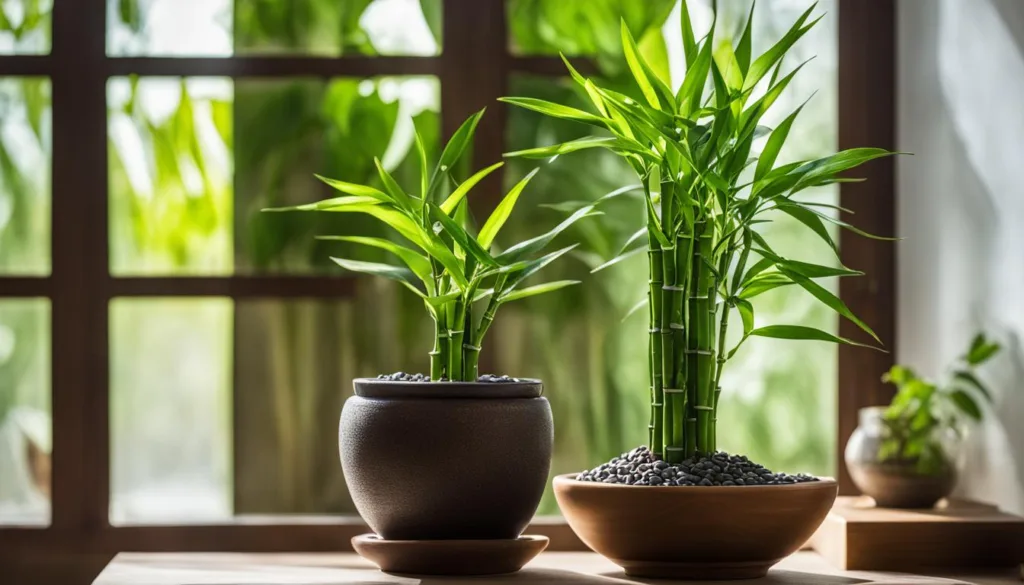
Growing lucky bamboo in soil provides a stable and nourishing environment for the plant’s roots. Here are some care instructions for successfully growing lucky bamboo in soil:
- Choose well-draining soil: Use a well-draining soil mix that is rich in organic matter. This will ensure that excess water can drain away, preventing root rot.
- Keep the soil slightly damp: Lucky bamboo prefers slightly moist soil, but be careful not to overwater. Allow the top inch of soil to dry out slightly before watering again.
- Monitor light levels: Lucky bamboo should be placed in an area with indirect light. Avoid exposing it to direct sunlight, as this can scorch the leaves.
- Remove yellow leaves: Regularly check the plant for any yellow or brown leaves and remove them promptly. This helps to maintain the plant’s overall health.
Remember: Lucky bamboo is toxic to cats and dogs, so make sure to keep it out of their reach. If you notice any pests, such as mealybugs or mites, you can manually remove them or treat the plant with a mixture of rubbing alcohol and water.
Comparison of Growing Lucky Bamboo in Water vs. Soil
| Growing in Water | Growing in Soil | |
|---|---|---|
| Watering | Change water every week | Keep soil slightly damp |
| Root Development | Roots grow in water | Roots grow in soil |
| Nutrient Availability | Requires liquid fertilizer in water | Nutrients present in soil |
| Maintenance | Regular water changes and cleaning | Monitoring soil moisture and removing yellow leaves |
| Plant Longevity | Shorter lifespan | Longer lifespan |
Both growing methods have their advantages, so choose the one that best suits your preferences and living conditions. With proper care and attention, lucky bamboo can thrive and bring a touch of nature to your indoor space.
The Art of Shaping Lucky Bamboo: Twists, Braids, and Spirals
Shaping lucky bamboo into elegant and intricate designs adds a touch of artistry to your indoor space. The twists, braids, and spirals created with lucky bamboo stems not only enhance its visual appeal but also carry deeper symbolism and meanings.
Whether you want to attract positive energy or simply enjoy the beauty of this ancient plant, learning how to twist and braid lucky bamboo can be a rewarding experience.
Twisting Lucky Bamboo
To create a twist in your lucky bamboo, you can manipulate its growth pattern by altering the light source. One method is to place the plant in a cardboard box and rotate it periodically as it leans towards the light. This gradual rotation will encourage the stems to grow in a spiral pattern, resulting in a captivating twisted bamboo plant.
Braiding Lucky Bamboo
Braiding lucky bamboo involves intertwining multiple stems together to create an intricate and decorative design. Begin by selecting three or more healthy stalks of lucky bamboo. Gently twist them around each other, similar to braiding hair.
Secure the ends with a rubber band or ribbon to hold the braid in place. This technique not only adds a unique touch to your lucky bamboo but also represents unity, strength, and the interconnection of different elements in life.
Spiraling Lucky Bamboo
Spiraling lucky bamboo is achieved by training the stems to grow in a graceful spiral pattern. Start by placing a support structure, such as a small dowel or metal rod, next to the lucky bamboo plant.
Gently wrap the stems around the support as they grow, guiding them in a spiral shape. Over time, the stems will follow the spiral path, creating a visually striking and harmonious display.
| Lucky Bamboo Design | Symbolism and Meanings |
|---|---|
| Twisted Bamboo | Continual growth and adaptability |
| Braided Bamboo | Unity, strength, and interconnectedness |
| Spiral Bamboo | Eternal harmony and balance |
By twisting, braiding, or spiraling your lucky bamboo, you not only create visually appealing designs but also amplify the positive energy and symbolism associated with this ancient plant. Let your creativity flourish as you shape your lucky bamboo into unique and meaningful expressions of art and nature.
Propagating Lucky Bamboo
If you’re looking to expand your collection of lucky bamboo or share its positive energy with others, propagating the plant is a simple and rewarding process. Lucky bamboo can be easily propagated through stem cuttings or division, both methods offering successful results.
Stem Cuttings:
To propagate lucky bamboo through stem cuttings, start by selecting a healthy stalk with at least two nodes. Using a clean pair of scissors, make a clean cut just below a node. Place the cutting in a container filled with clean water, making sure that at least one node is submerged.
Leave the cutting in a well-lit area, away from direct sunlight. Within a few weeks, roots will start to develop from the node. Once the roots are well-established, the cutting can be transferred to soil or kept in water as a standalone plant.
Division:
Division is another method of propagating lucky bamboo and is ideal when you have a mature plant with multiple stalks. Carefully remove the plant from its container and separate the stalks into individual sections, ensuring each section has its own root system.
Plant each section in its own container filled with well-draining soil or place it in a container with clean water. Keep the plants in a well-lit area, and within a few weeks, new growth will emerge.
Remember to:
- Use clean tools to prevent the spread of diseases or pests.
- Ensure the cuttings or divisions have at least one node, as this is where new roots will develop.
- Provide adequate light and proper care to promote healthy growth.
- Monitor the moisture levels and avoid overwatering to prevent root rot.
With proper care and patience, propagating lucky bamboo can be a fun and fulfilling experience, allowing you to enjoy the beauty and positive energy of this remarkable plant.
| Propagation Method | Description |
|---|---|
| Stem Cuttings | Select a healthy stalk, cut below a node, and place in water or soil until roots develop. |
| Division | Separate a mature plant into individual sections, each with its own root system, and plant in water or soil. |
Lucky Bamboo Care FAQs
As a popular plant in Feng Shui and a symbol of luck and prosperity, lucky bamboo requires proper care to thrive. Here are some frequently asked questions about caring for lucky bamboo:
How do I care for lucky bamboo?
To care for lucky bamboo, keep it in indirect light and maintain a temperature range of 65-95°F. When grown in water, change the water every week to prevent algae growth. If grown in soil, keep the soil slightly damp, but not overly wet. Remove any yellow leaves and repot when roots become too tight. Avoid overwatering and fertilize sparingly.
Can I trim lucky bamboo?
Yes, you can trim lucky bamboo to maintain its desired shape. Use clean, sharp scissors to trim the stalks at an angle, just above a node. Trimming can help control the size and shape of the plant and promote new growth.
What should I do if my lucky bamboo leaves turn yellow?
If your lucky bamboo leaves turn yellow, it could be a sign of overwatering, too much direct sunlight, or poor water quality. Adjust the watering schedule, move the plant to a spot with indirect light, and use clean, filtered water. Removing yellow leaves will also help maintain the plant’s health.
| Question | Answer |
|---|---|
| How often should I water lucky bamboo? | When grown in water, change the water every week. When grown in soil, keep the soil slightly damp, watering every 1-2 weeks. |
| Can I use tap water for lucky bamboo? | It is recommended to use clean, filtered, or distilled water to prevent harmful chemicals from affecting the plant. |
| Is lucky bamboo toxic to pets? | Yes, lucky bamboo is toxic to cats and dogs. Keep it out of their reach to ensure their safety. |
| How often should I fertilize lucky bamboo? | Fertilize lucky bamboo sparingly, using a balanced liquid fertilizer every 2-3 months. |
Stylish Lucky Bamboo Varieties
If you’re looking to add a touch of elegance and symbolism to your home or office, consider incorporating stylish lucky bamboo varieties into your space. These unique plants not only bring beauty and tranquility but also carry their own meanings and symbolism.
The Symbolic Meanings of Lucky Bamboo Varieties
Lucky bamboo towers are believed to bring brightness and a positive future. Their tall and slender stalks symbolize growth and upward progress. These varieties are perfect for creating a focal point or adding height to your space.
Braided lucky bamboo canes are another popular choice. The intertwined stalks represent unity and strength. They are often associated with good news and attract new developments. Braided lucky bamboo adds an eye-catching element to any room and serves as a reminder of the power of harmony.
Woven trellises made from lucky bamboo symbolize the elimination of negative energies. These intricate designs not only showcase the plant’s versatility but also create a sense of balance and tranquility. Woven trellises are excellent for promoting a peaceful and harmonious environment.
| Lucky Bamboo Variety | Symbolic Meaning |
|---|---|
| Lucky Bamboo Towers | Brightness and a positive future |
| Braided Lucky Bamboo Canes | Good news and new developments |
| Woven Trellises of Lucky Bamboo | Elimination of negative energies |
By selecting different lucky bamboo varieties, you can not only enjoy the visual appeal they bring but also imbue your space with positive energy and symbolism. Whether you choose lucky bamboo towers, braided canes, or woven trellises, these stylish varieties are sure to enhance the ambiance and create a serene atmosphere.
The Superstition of Lucky Bamboo Stalks
In Chinese culture, the number 4 is considered unlucky due to its similarity in pronunciation to the word for “death.” As a result, lucky bamboo with four stalks is avoided as it is believed to bring bad luck. On the other hand, the number 8 is highly regarded and associated with wealth and joy.
Many people choose addresses, phone numbers, and even business names that include the number 8 for its auspiciousness. Similarly, the number 9 is considered lucky and represents good fortune and success.
In the world of lucky bamboo, superstitions play a significant role. Understanding the symbolism behind the number of stalks can help individuals create a harmonious and positive environment.
Whether you believe in these superstitions or not, lucky bamboo continues to be a popular plant known for its beauty and the positive energy it brings to its surroundings.
The Superstition of Numbers in Lucky Bamboo
To understand the superstition surrounding lucky bamboo stalks, it’s important to delve into Chinese culture and its significance to Feng Shui. The number 4 is considered unlucky due to its association with death and should be avoided.
The number 8 is highly regarded for its connection to wealth and joy, making it an auspicious number in Chinese culture. Similarly, the number 9 is associated with good fortune and success, making it a positive choice for lucky bamboo arrangements.
These superstitions have a significant impact on the way lucky bamboo is presented and used in homes, offices, and businesses. Whether it’s choosing the number of stalks or incorporating lucky bamboo into different shapes and designs, these symbolic choices are believed to bring positive energy and prosperity to the environment.
Creating a Harmonious Environment with Lucky Bamboo
While the superstitions surrounding lucky bamboo stalks may seem like mere beliefs, they contribute to the overall harmony and positive energy in a space. By understanding the symbolism behind the numbers, individuals can create arrangements that align with their intentions and desires.
Whether you’re seeking wealth, joy, or success, lucky bamboo can serve as a powerful tool to enhance the energy and ambiance of any space.
Taking care of a lucky bamboo plant is easy and rewarding. By following a few simple tips, you can ensure its health and longevity. First, choose whether to grow it in soil or water, keeping in mind that soil provides a more nourishing environment.
If growing in water, change it weekly to prevent bacterial growth. In soil, keep the soil slightly damp but avoid overwatering. Additionally, make sure the plant is placed in indirect light and maintain a temperature range of 65-95°F for optimal growth.
It’s important to understand the symbolism behind the number of stalks in a lucky bamboo plant. Each number holds a different meaning, so choose the number that aligns with your intentions. Lucky bamboo is believed to bring good fortune and positive energy to its surroundings, making it a great addition to any home or office.
In summary, lucky bamboo is not only a beautiful plant but also a symbol of luck and prosperity. By caring for it properly and harnessing its symbolism, you can create a positive and harmonious environment. Whether you use it for Feng Shui purposes or simply as a decorative plant, lucky bamboo brings beauty, joy, and good fortune.
FAQ
Can lucky bamboo be grown in water?
Yes, lucky bamboo can be grown in water. It is important to use clean, distilled, or filtered water and change it every week to prevent the buildup of bacteria and algae.
How often should I water lucky bamboo grown in soil?
Lucky bamboo grown in soil should be kept slightly damp, but not overly wet. It is important to monitor the moisture levels and avoid overwatering, as it can lead to root rot.
What is the ideal light condition for lucky bamboo?
Lucky bamboo prefers indirect light. It should be placed in a location where it can receive bright, indirect light throughout the day.
How often should I fertilize lucky bamboo?
Lucky bamboo grown in water can be fertilized with a few drops of liquid fertilizer every few months. Lucky bamboo grown in soil can be fertilized with a balanced liquid fertilizer following the instructions on the product label.
How do I shape lucky bamboo into different designs?
You can shape lucky bamboo into twists, braids, and spirals by manipulating the light source or intertwining multiple stalks together using a simple braiding technique.
How can I propagate lucky bamboo?
Lucky bamboo can be propagated through stem cuttings or division. Stem cuttings involve cutting a healthy stalk below a node and placing it in water until roots develop. Division involves separating a mature plant into multiple sections, each with its own stalk and root system.
Can lucky bamboo be grown outdoors?
Lucky bamboo is typically grown indoors as a houseplant. However, in tropical climates, it can be grown outdoors in shaded areas.
Can pets eat lucky bamboo?
No, lucky bamboo is toxic to cats and dogs. It should be kept out of their reach to prevent ingestion.
How do I prevent pests from affecting my lucky bamboo?
Common pests that can affect lucky bamboo include mealybugs and mites. They can be removed manually or treated with rubbing alcohol and water.
What are the benefits of having lucky bamboo in my home or office?
Lucky bamboo is known for its air-purifying qualities, ability to promote positive energy, reduce stress, and create a sense of calmness. It is believed to bring prosperity and good luck.

